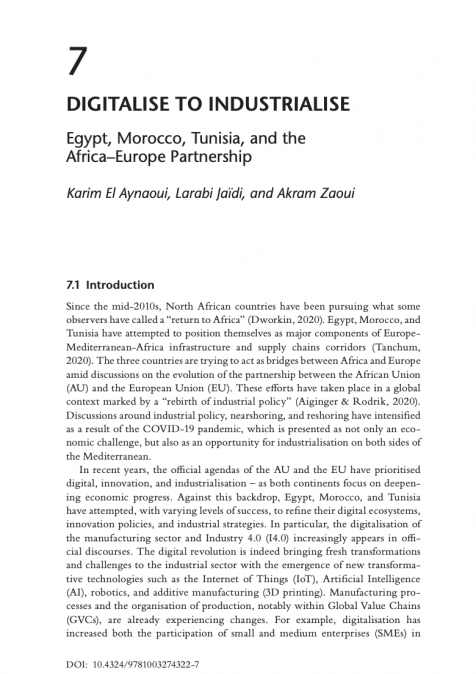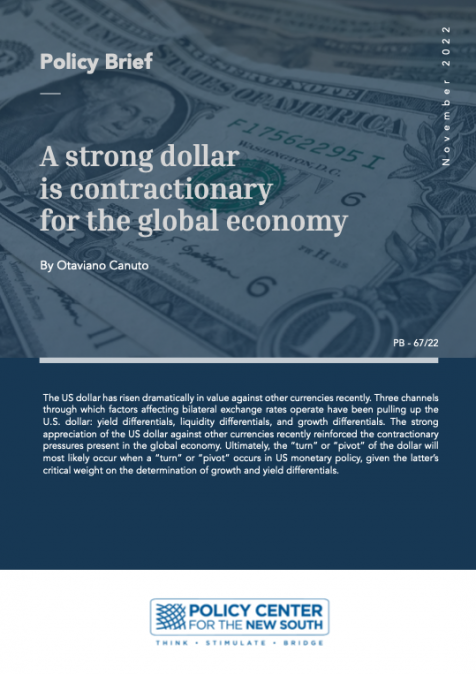Publications /
Opinion
The author is an alumnus of the Atlantic Dialogues Emeging Leaders Program 2014.
The discussion on industry 4.0 (also often referred to as smart manufacturing or industrial internet of things – which is the term mostly used in the United States of America) has graduated from being a niche topic discussed (and implemented) by engineers in the world’s richest economies. If industry 4.0 has not physically arrived everywhere, it is at least in the minds of some: industry 4.0 in Africa, industry 4.0 in the food industry, industry 4.0 for medical devices, industry 4.0 in agriculture…
What is industry 4.0?
There is no single definition of industry 4.0. Definitions of the term, and the technologies it includes can vary depending on the entity and use-case. The German government (which coined the term earlier this decade) defines industry 4.0 as “the intelligent networking of machines and processes for industry with the help of information and communication technology”, and the Institute for Mittelstandsforschung in Germany defines industry 4.0 more concisely as “technological integration of cyber-physical systems in the production process.” McKinsey defines industry 4.0 “as the next phase in the digitization of the manufacturing sector, driven by four disruptions: the overwhelming rise in data volumes, computational power, and connectivity, especially new low-power wide-area networks; the emergence of analytics and business-intelligence capabilities; new forms of human-machine interaction such as touch interfaces and augmented-reality systems; and improvements in transferring digital instructions to the physical world, such as advanced robotics and 3-D printing.”
Why is industry 4.0 important for frontier countries?
Even without a set definition, virtually all leading global consulting firms battle for positions as thought-leaders in the implementation of industry 4.0 solutions (see for example Deloitte, Ernst and Young, Accenture, McKinsey, or Boston Consulting Group). The market for industry 4.0 solutions is large and growing. And its implementation has implications of the future development of every sector and economy. To remain relevant and competitive, most manufacturing businesses must evaluate how to effectively optimize their operations – and integrating industry 4.0 technologies is the obvious way to do so. According to Simon Weallans from Automation Alley, in the US “businesses that embrace industry 4.0 consistently see significant improvements in productivity, quality, product purchasing costs and manufacturing costs.”
This is particularly relevant for Small and Medium Enterprises (SMEs) that are globally the engine for employment and economic activity – especially in emerging countries. SMEs are the backbone of economies, accounting for an estimated 400 million businesses worldwide and providing 60% of jobs and contributing 40% to GDP in emerging economies.
While industry 4.0 is often seen in developed countries as a mechanism for “bringing back” manufacturing jobs [1], it has the potential of eroding the advantage of enterprises—and nations hosting them—that have specialized in low-cost, low-tech, labor-intensive manufacturing activities. Some companies are reshoring their production to be closer to consumers and to harness the skilled labor force and infrastructure needed for smart production methods. Yet, this threat to frontier economies can be an opportunity for those that are able to implement new production methods – to increase resource efficiency and minimize waste by introducing smart production techniques into manufacturing. By doing so, economies can increase their productivity potential, increase incomes, and improve overall the quality of life.
What can governments do to bring industry 4.0 solutions to SMEs?
The German government has numerous policies to incentivize and encourage industry 4.0, including a network of 25 innovation centers targeted towards SMEs. The industry 4.0 Competence Centers (Mittelstand 4.0 Kompetenzzentrum) introduce digitalization and networking technologies to German manufacturing SMEs. These centers are government-owned and run, but work hand-in-hand with private business through industry representation on boards, close collaboration through networks, and the sharing of management of certain centers with the private sector.
In France, the Alliance Industrie du Futur spreads knowledge on connectivity in production processes to domestic business, and CLARTE, a technological resources center specialized in augmented reality and other emerging technologies, provides technology consulting and research and technology transfer services to SMEs in form of a public-private partnership. Similar centers both privately run (e.g. Automation Alley in the US) and publicly run (e.g. NAMIC in Singapore) have emerged around the globe.
These physical industry 4.0 centers have a common goal: to increase companies’ global competitiveness and build innovation capacity through new, technology-driven production processes. The centers create and cultivate innovation networks, and some provide certified trainings to improve SME’s human capital. Innovation centers also help define and establish industry standards of new technologies.
Nevertheless, we need to keep in mind that each of these examples above is buttressed by a strong innovation ecosystem with a highly skilled workforce and a vibrant economy that makes the industry 4.0 centers viable. The background conditions are hardly ever similar (at least not to the same degree) in frontier economies.
What type of support models should be introduced in emerging economies?
There are more and more examples of public support for industry 4.0, such as the Technology Centre Systems Project in India, and the Export Competitiveness for Jobs project in Bangladesh. Different donors recognize the desperate need for companies in frontier economies to compete globally, including the German government through GIZ in Tunisia. Malaysia, where the government is known to provide a cornucopia of interventions to promote innovation in domestic firms, has passed a national policy on industry 4.0 and currently conducts a readiness assessment to eventually help 500 local SMEs migrate to industry 4.0 productions by 2021.
Who should receive support?
Malaysia’s readiness assessment is probably the most sensible start and a tool that can be transferred to and adapted by other economies. It will help gauge if there is a critical mass of firms ready, willing and able to introduce industry 4.0 technologies. On top of the readiness of firms, the socio-economic background of the country as a whole must be given. There needs to be a general level of skills aptitude, adequate industry standards and financing mechanism for industry upgrading already in place. Not all firms or all sectors in every country will be able to implement industry 4.0 technologies and interventions should be targeted only towards those firms will be able to thrive. Sound economic development, as well as educational policy, need to strategically address structural gaps in management, human resource capacity and infrastructure.
For policy makers around the world, the following simple steps could be a starting point to develop a successful intervention to support industry 4.0 for SMEs, such as the different technology centers around the world do:
- See if there are sectors that can benefit from industry 4.0 solutions, ideally being imbedded in global value chains
- Identify if there are the skills within the workforce and technical capacity in different sectors to absorb industry 4.0 (or can it easily be obtained)
- Gauge if there is an industry demand for new production methods
- Identify eventually sustainable ways to finance production method
- Review and potentially revise the regulatory environment (including the setting of industry standards) that will facilitate the uptake of industry 4.0 solutions
- Develop a government support model with your stakeholders that can reach as many capable businesses as possible (this may have to focus on few sectors or light house interventions first)
- Monitor success as well as failures of these interventions and make changes accordingly
- Promote success stories early on and share lessons learned with your peers – lessons are likely transferable between sectors.
1 - “Bringing back” jobs may be a popular term, but is technically not correct since these are newly created and mostly highly skilled jobs in the manufacturing sector









